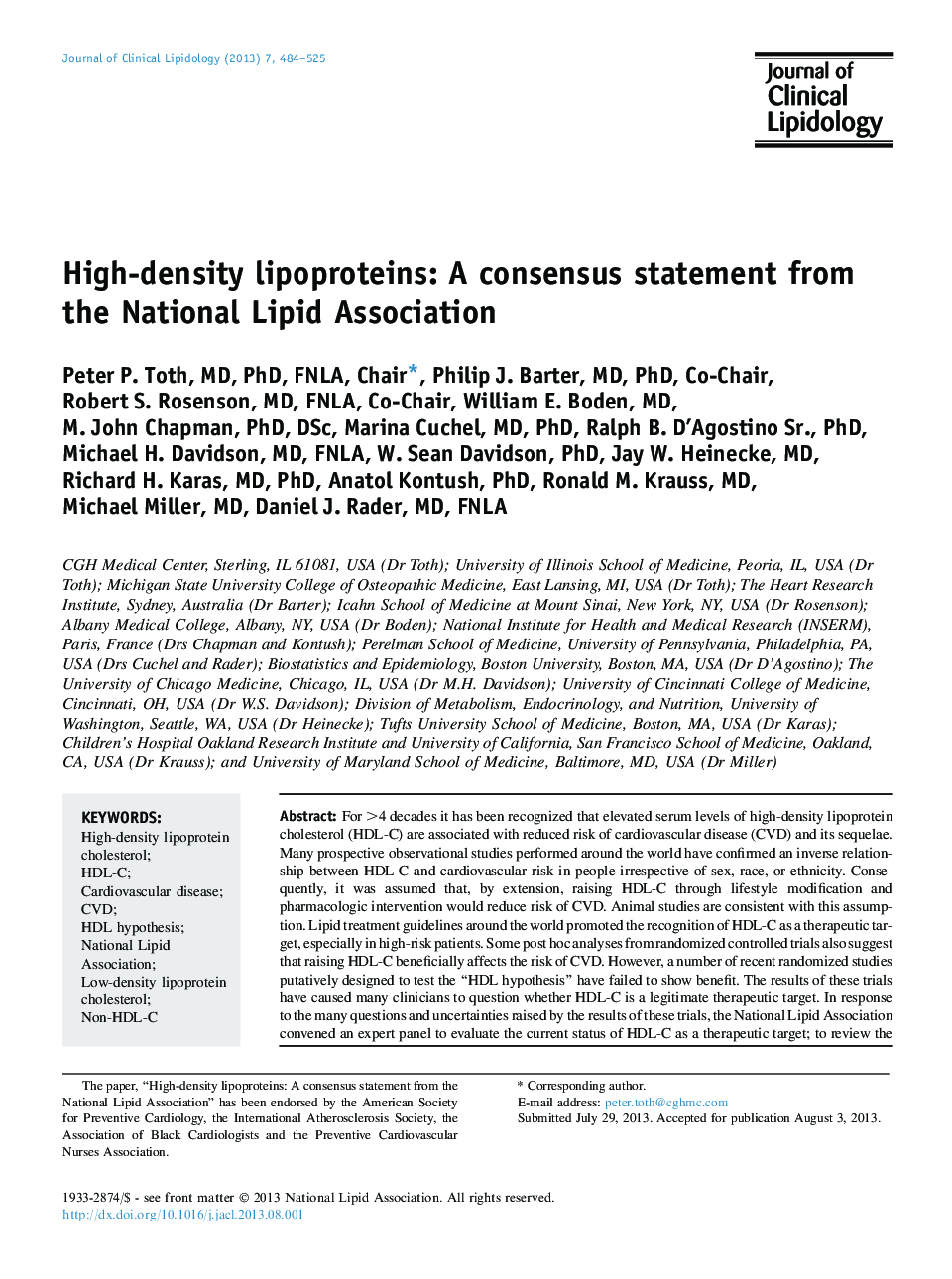| Article ID | Journal | Published Year | Pages | File Type |
|---|---|---|---|---|
| 5986090 | Journal of Clinical Lipidology | 2013 | 42 Pages |
⺠The National Lipid Association High Density Lipoprotein Consensus Panel concludes that low levels of high-density lipoprotein cholesterol (HDL-C) identifies individuals at elevated risk for cardiovascular disease.⺠A number of recent randomized studies, which attempted to test the HDL hypothesis, failed to show benefit, causing clinicians to question whether HDL-C is a legitimate therapeutic target. At this time, the expert panel agrees that there is insufficient evidence to support the use of therapeutic interventions to raise low serum levels of HDL-C. Rather, risk-stratified atherogenic lipoprotein burden (low-density lipoprotein cholesterol and non-HDL-C) should remain the primary and secondary therapeutic targets for patients at risk for cardiovascular disease.⺠However, consensus panel emphasizes the need for continued rigorous research into the biology and clinical significance of low levels of HDL-C, and into the development of novel drugs designed to modulate HDL structure and function.
For >4 decades it has been recognized that elevated serum levels of high-density lipoprotein cholesterol (HDL-C) are associated with reduced risk of cardiovascular disease (CVD) and its sequelae. Many prospective observational studies performed around the world have confirmed an inverse relationship between HDL-C and cardiovascular risk in people irrespective of sex, race, or ethnicity. Consequently, it was assumed that, by extension, raising HDL-C through lifestyle modification and pharmacologic intervention would reduce risk of CVD. Animal studies are consistent with this assumption. Lipid treatment guidelines around the world promoted the recognition of HDL-C as a therapeutic target, especially in high-risk patients. Some post hoc analyses from randomized controlled trials also suggest that raising HDL-C beneficially affects the risk of CVD. However, a number of recent randomized studies putatively designed to test the “HDL hypothesis” have failed to show benefit. The results of these trials have caused many clinicians to question whether HDL-C is a legitimate therapeutic target. In response to the many questions and uncertainties raised by the results of these trials, the National Lipid Association convened an expert panel to evaluate the current status of HDL-C as a therapeutic target; to review the current state of knowledge of HDL particle structure, composition, and function; and to identify the salient questions yet to be answered about the role of HDL in either preventing or contributing to atherosclerotic disease. The expert panel's conclusions and clinical recommendations are summarized herein. The panel concludes that, although low HDL-C identifies patients at elevated risk, and much investigation suggests that HDL may play a variety of antiatherogenic roles, HDL-C is not a therapeutic target at the present time. Risk stratified atherogenic lipoprotein burden (low-density lipoprotein cholesterol and non-HDL-C) should remain the primary and secondary targets of therapy in patients at risk, as described by established guidelines. The National Lipid Association emphasizes that rigorous research into the biology and clinical significance of low HDL-C should continue. The development of novel drugs designed to modulate the serum levels and functionality of HDL particles should also continue. On the basis of an enormous amount of basic scientific and clinical investigation, a considerable number of reasons support the need to continue to investigate the therapeutic effect of modulating HDL structure and function.
